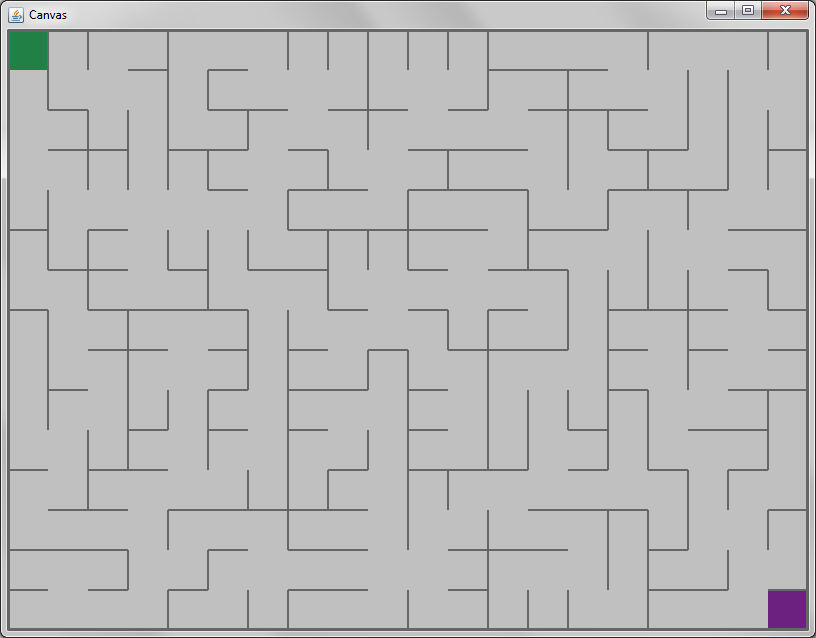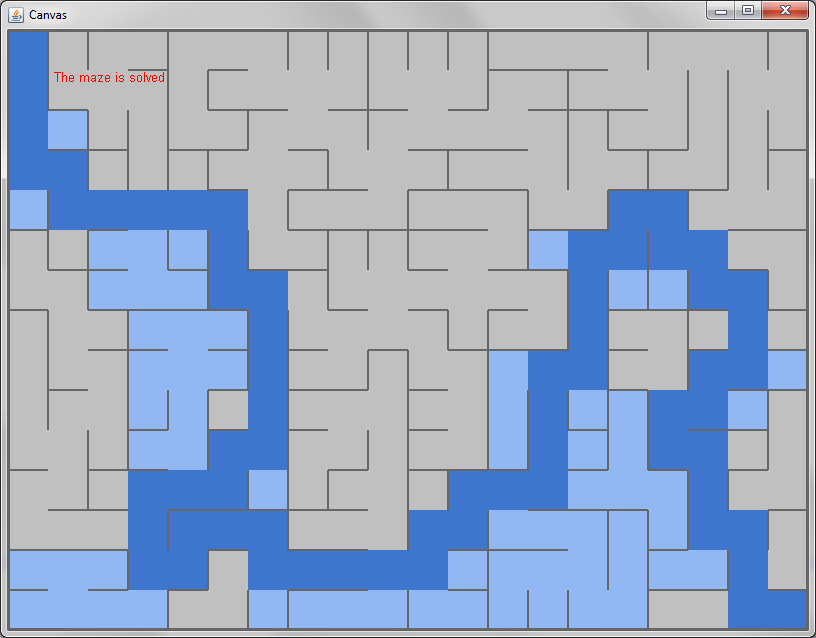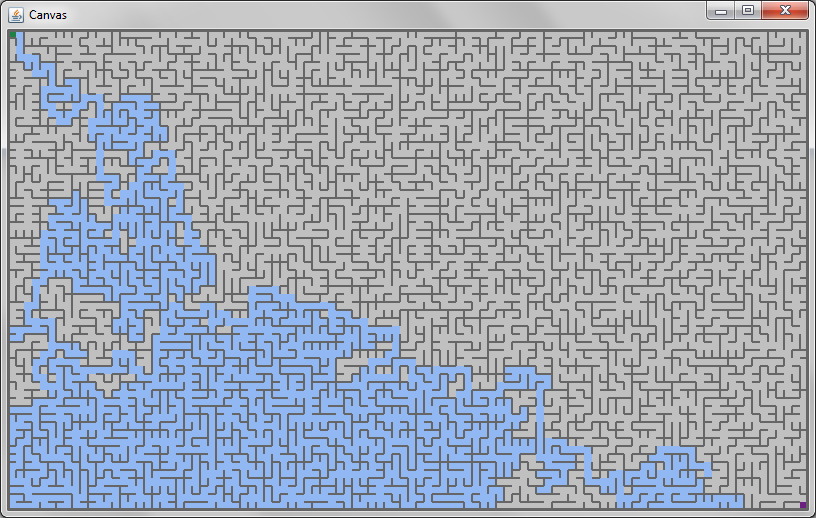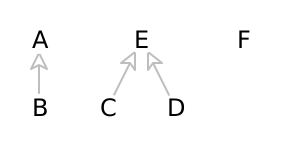Assignment 10: Maze of twisty passages
Goals: Practice working with graphs and graph algorithms by designing mazes using Kruskal’s algorithm, and solving them using either breadth- or depth-first searches.
Due: Tuesday, April 15th at 9:00pm
import java.util.ArrayList; import tester.*; import javalib.impworld.*; import java.awt.Color; import javalib.worldimages.*;
Make sure you do not name any of your files World.java, or else the autograder will not be able to compile your code.
Read the entire assignment before starting! Most of your likely questions are probably addressed in here, just not merely in the Requirements section...
Extra credit will only count if they are convincingly and
thoroughly tested, and if the rest of the assignment is completed equally
thoroughly —
In class, we have been discussing various algorithms for working with graphs, that require the use of several data structures working together. We have talked about general-purpose maze searching algorithms, like breadth- and depth-first searches, and we have talked about building minimum spanning trees on graphs.
To get a visual grasp of how these algorithms work, you are going to be building and solving mazes, like this one:

The mazes you construct should start in the upper-left corner (shown in green) and end in the lower-right corner (shown in purple). As you solve the mazes, you should color in the cells you have explored. Once you have reached the solution, you must backtrack the path from the end to the start, and draw it as well. A fully-solved maze might look like this:

Your code must handle mazes of arbitrary sizes, up to at least 100x60:

In particular, your code must not crash with stack overflows...
10.1 Requirements
All your classes’ fields must be marked private. As many as possible must also be marked final. You should avoid any gratuitous getter methods: in other words, a purpose statement of "getFoo(): Gets the foo field" is not a sufficient reason for that method to exist. You may try "Gets the foo field, as needed by somethingElse()", but you’ll need to justify why somethingElse really needs access to that field.
If you cannot make a field final or private, leave a comment explaining what other code is permitted to modify or access it, and why. (Remember that final is shallow: even if an ArrayList variable is marked final, you may still mutate the contents of that list; all you are prevented from doing is reassigning that variable.)
Construct random mazes using Kruskal’s algorithm and Union/Find (below)
Display the maze graphically and animate the search for the path.
Allow the user to choose one of two algorithms for finding the path: Breadth-First Search or Depth-First Search (below).
Provide an option for designing a new random maze.
Allow the user to traverse the maze manually - using the keys to select the next move, preventing illegal moves and notifying the user of completion of the game.
Display the solution path connecting the start and end, once it’s found (either automatically or by the user).
Be sure to submit documentation for your code, so the graders know how to run and play your game. As always, be sure to test your code thoroughly.
By Friday, April 11th, be able to create mazes and draw them
By Tuesday, April 15th, be able to solve (and animate the solutions of) mazes using either breadth- or depth-first search
Additionally, you may attempt bells and whistles for extra credit:
Provide an option to toggle the viewing of the visited paths.
Allow the user the ability to start a new maze without restarting the program.
Keep the score of wrong moves —
for either the automatic solutions or manual ones — and maybe keep statistics on which one of the two algorithms had fewer steps for each maze.
In addition to animating the solution of the maze, also animate the construction of the maze: on each tick, show a single wall being knocked down.
Color every square with a gradient of colors indicating how far it is from the start of the maze. E.g. red means very close to the start, and blue means very far.
Color every square with a gradient of colors indicating how far it is from the exit of the maze. E.g. red means very close to the exit, and blue means very far. (Are these colors exactly the opposite of the previous ones, or is this a different color pattern altogether?)
(Tricky) Construct mazes with a bias in a particular direction —
a preference for horizontal or vertical corridors. (Hint: you might wish to play tricks with the edge weights here.) - Hard! (But very cool) Instead of constructing a rectangular maze, try constructing a hexagonal one. To do this, you’d need:
To figure out how to render a hexagon. See The Image Library.
To figure out how to represent a hexagonal grid. You’ll need to update your maze-cell class to have six neighbors instead of four. You’ll also need to figure out how to represent a hexagonal grid using a normal ArrayList<ArrayList<YourMazeCell>>. (Hint: if you look at the rows of a hexagonal grid, every other row is “shifted” by half a cell-width, but there are the same number of cells in every row, so a regular ArrayList<ArrayList<YourMazeCell>> should still work.)
To figure out how to render a hexagonal grid. You’ll need a little bit of math to figure out the centers of each hexagon.
To figure out how to do maze generation. Your initial graph will need to be a bit different...
To figure out user-input controls. I suggest using the letter ‘a’, ‘w’, ‘e’, ‘d’, ‘x’ and ‘z’, to mean their “obvious” directions (relative to the letter ‘s’ on the keyboard). If you also implement two-player mode, you’ll need to come up with different letters for that player and/or the maze-resetting letters.
Tricky Construct two intertwined mazes, and allow two players to race from their starting points to their ending points. Choosing the start points for both mazes is easy; choosing end points is harder. Even more impressive is ensuring that it’s a fair race, and both mazes have the same length path from start to finish... (Hint: how can you force Kruskal’s algorithm to produce two distinct connected mazes? Talk to an instructor if you choose to do this, and are not sure how to proceed.)
Spend careful thought planning ahead and designing your classes: if your design is too brittle, you’ll have a very hard time completing the algorithms. And as always, have fun!
10.2 Kruskal’s Algorithm for constructing Minimum Spanning Trees
Here is Kruskal’s algorithm illustrated on a particular example graph:

(The edges are drawn without directional arrows; in your mazes, every maze cell will be connected to its four neighbors, so edges are effectively undirected. Edge weights are notated as numbers on the edges.)
(E C 15) (C D 25) (A B 30) (B E 35) (B C 40) (F D 50) (A E 50) (B F 50)
At each step we remove the shortest edge from the list and add it to the spanning tree, provided we do not introduce a cycle. In practice, this may produce many trees during the execution of the algorithm (so in fact, the algorithm produces a spanning forest while it runs), but they will eventually merge into a single spanning tree at the completion of the algorithm.
while (we do not yet have a complete spanning tree) |
find the shortest edge that does not create a cycle |
and add it to the spanning tree |
Do Now!
Why can’t we have fewer edges? Why can’t we have more?
10.3 The Union/Find data structure
The goal of the union/find data structure is to allow us to take a set of items (such as nodes in a graph) and partition them into groups (such as nodes connected by spanning trees) in such a way that we can easily find whether two nodes are in the same group, and union two disjoint groups together. Intuitively, we accomplish this by naming each group by some representative element, and then two items can be checked for whether they are in the same group by checking if they have the same representative element.
10.3.1 Example
In class, we represented every node of the graph as a class with a String name field. (For this assignment, String names will be inconvenient; you will need to come up with some other uniquely-identifying feature of each cell in a maze that can serve the same role as a name.) Then the union-find data structure was a HashMap<String, String> that mapped (the name of) each node to (the name of) a node that it is connected to. Initially, every node name is mapped to itself, signifying that every node is its own representative element, or equivalently, that it is not connected to anything.
Recall the example from above:

Our HashMap will map every node name to itself:
Representatives as table |
| Representatives, visually |
|
|
|
Spanning tree so far:
(E C 15) (C D 25) (A B 30) (B E 35) (B C 40) (F D 50) (A E 50) (B F 50)
When we add edge (EC 15), nodes E and C are now connected:
Representatives as table |
| Representatives, visually |
|
|
|
(C E) |
We next add edge CD(25). Since C’s representative is E, and D’s representative is D, they are currently separate, so adding this edge would not create a cycle. We can therefore union them and set D’s representative’s representative to C’s representative:
Representatives as table |
| Representatives, visually |
|
|
|
Spanning tree so far: (C D) (C E)
Do Now!
Careful! Why must we union the representatives of two nodes, and not the nodes themselves?
Suppose we goofed, and connected the two nodes we care about directly, rather than connecting their representatives. If one of the nodes already was connected to some other nodes, then changing this connection would disconnect it from the nodes it was already unioned with, which would break our data structure and produce an inconsistent state. Our example so far hasn’t yet reached this stage, but it will, soon.
(Note that we could have chosen the other ordering, and set C’s representative’s representative to D’s representative. This would mean the same thing, because both C and D would be part of the same unified group, but in this case it would create a taller tree, which means it would take longer in the future to find the representative for C.)
Next we add edge AB(30). We’ll set B’s representative’s representative to A’s representative:
Representatives as table |
| Representatives, visually |
|
|
|
Spanning tree so far: (A B) (C D) (C E)
We now have three connected components: Nodes B and A form one of them, node F is a singleton, and nodes C, D, and E are in the third component.
We add edge BE(35). That means we add a link between the representative for B (which is A) and the representative for node E (which is E). This time for variety, we’ll choose to connect A to E instead of the other order:
Representatives as table |
| Representatives, visually |
|
|
|
Spanning tree so far: (A B) (B E) (C D) (C E)
Do Now!
We chose arbitrarily to connect A to E. Draw the result if we had connected E to A instead.
Do Now!
Again, be careful! Why must we union the representatives of two nodes, and not the nodes themselves?
At this point if we had incorrectly connected B directly to E, then we would disconnect it from A, and so we would lose track of the fact that A is connected to E (by way of the edge BE).
We still have two components. When we try to add the edge BC(40) to the graph, we notice that the representative for node C is the same as the representative for the node B. Therefore adding this edge would create a cycle, so we discard it.
Finally, we add the edge FD(50). After this, every node has the same representative, and therefore all nodes are connected:
Representatives as table |
| Representatives, visually |
|
|
|
Spanning tree so far: (A B) (B E) (C D) (C E) (D F)
10.4 Putting the union/find data structure to work
HashMap<String, String> representatives; List<Edge> edgesInTree; List<Edge> worklist = all edges in graph, sorted by edge weights; initialize every node's representative to itself While(there's more than one tree) Pick the next cheapest edge of the graph: suppose it connects X and Y. If find(representatives, X) equals find(representatives, Y): discard this edge // they're already connected Else: Record this edge in edgesInTree union(representatives, find(representatives, X), find(representatives, Y)) Return the edgesInTree
There are additional heuristics for speeding this algorithm up in practice, and they make for a very efficient algorithm. Unfortunately, analyzing these heuristics is beyond the scope of this course, but you can look up the “path-compression” heuristic if you are curious.
Do Now!
Again, why must we only ever union two representatives, and not two arbitrary nodes?
10.5 Breadth- and depth-first search
HashMap<String, Edge> cameFromEdge; |
???<Node> worklist; // A Queue or a Stack, depending on the algorithm |
|
initialize the worklist to contain the starting node |
While(the worklist is not empty) |
Node next = the next item from the worklist |
If (next has already been processed) |
discard it |
Else If (next is the target): |
return reconstruct(cameFromEdge, next); |
Else: |
For each neighbor n of next: |
Add n to the worklist |
Record the edge (next->n) in the cameFromEdge map |











